
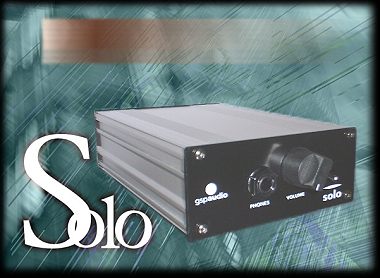
Manufacturer: gspaudio
Price: £399 (approx $530 US) Including PSU1
power supply
NOTE: The amp is £299
without the PSU1 and comes supplied with a standard plug top PSU
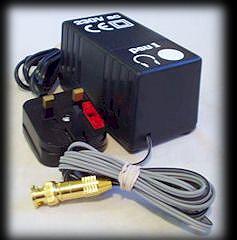
Tested using the PSU1 power supply
This little amp first came to my attention after I spotted a secondhand MK11 for sale on e-bay. I contacted Graham Slee asking him if there would be any benefit in fitting "exotic" capacitors etc. to the MK11 and we exchanged quite a few in-depth e-mails on this subject. Graham soon became aware of my passion for anything "headphone" related and he was also aware of my website and my tendancy to analyse equipment from top to bottom for all the world to see! I had a lot of questions about the difference of his new MK111 over the MK11 and Graham very kindly offered (insisted!) to send me a brand new MK111 to try out and asked me to be brutally honest with my findings. Couldn't get fairer than that!
Graham really does come across as totally transparent
and is not afraid to hide any details of his design. He certainly puts
the customer at the top of his priorities and values customer feedback,
as Graham put it "after all, without customers I'm nothing"
If only more manufacturers would adopt that approach. Graham doesn't resort
to using glossy buzz-words like "Mil-spec volume knobs" or "Lifestyle
compatible design" like some of the well known crud-mongers who cook
up vastly overpriced, 99% injection moulded plastic garbage boasting meaningless
"specs" Graham calls a switch a switch and a knob a knob.
Solo couldn't be a more apt name for the amp as Graham hand builds all of his designs from his premises in South Yorkshire. He is responsible for everything from the design stage upward, he even packs the amps ready for shipping. Quality control is assured as Graham is passionate about his work and he builds all of his products as if he were building them for himself. He won't let anything leave his workshop unless it measures up to his standards 100% He doesn't work on the + / - 20% tolerance standard, with Graham "Zero tolerance" is the order of the day.
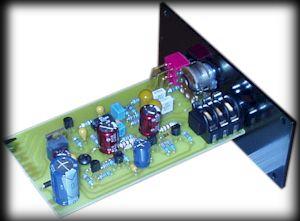
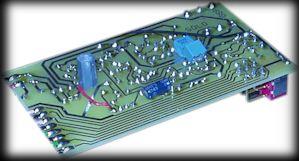
The first
thing that struck me when I unwrapped the amp was the overall quality
of the unit. Housed in a silver anodised case with screenprinted graphics,
the amp looks like it's built to last. The front fascia is fitted with
a source selector switch, a volume knob and a headphone socket. The fit
and finish is superb. There is no obligatory LED indicating On / Off which
I assume was ommitted on the grounds of "sound quality" I prefer
to see a little glowing light but, as the amp has been designed to be
left on permanently, it makes sense not to have an LED.
The rear panel of the amp is fitted out with 4 Very
high quality Gold plated Teflon insulated RCA sockets (not your usual
cheap block connectors) and a high quality bayonet lock DC socket which
is far superior to the usual 2.1mm DC connectors. The feet are small transparent
sorbothane types and I feel these could be a lot thicker / wider as they
really don't provide a firm footprint for the amp, especially when using
heavy interconnects. This is a small gripe and it's easy enough to replace
the feet with something a bit more substantial.
The amp came complete with offboard PSU1 power supply featuring 4 x Panasonic FC high temp, low impedance capacitors; Elna Starget output filter; Heatsinked regulator; Fuse cassette; FR4 woven epoxide glass PCB all safely housed in the ULVO-94 flame retardant case. The amp can be supplied with a standard plug top PSU and this knocks £100 off the price.
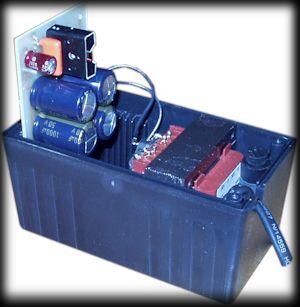
Interior of the PSU1
A quick look under the bonnet confirmed the same attention to detail and quality had been afforded to the interior. From experience a lot of manufacturers go out of their way to produce "eye candy" exteriors and then fill the interior with the cheapest of cheap components they can lay their hands on (a pretty well known black amp shaped like a tube springs to mind!) well, Graham certainly hasn't skimped on the parts cost in the Solo.
At the heart of the amp lies an AD 826 operational amplifier renowned for its extremely fast settling rate, this is a highly regarded op amp by many in DIY circles. There are a sprinkling of audio grade ELNA Starget capacitors, a couple of standard ELNA's, a couple of ERC electrolytics (bypassed by Evox polypropylenes on the underside of the board) an ALPS potentiometer and the usual sprinkling of metal film resistors.
The components were very well laid out and the solder work absolutely first class. I examined each joint with my magnifying glass looking for dry joints and can report that each and every joint was soldered to Military Specs (My words "not" Grahams!!!!!!!!!) Superb work.

Questions and answers
Q: You say the amp is AC coupled Graham, what does this mean and why do you adopt AC coupling in your design?
"Well, this all stems from my distrust of the overuse of electronics to achieve what in my opinion is a simple task. If I were to have done this as a DC coupled design I would have had to servo the output. A servo is necessary to zero the output offset. Either that or you ac couple the bottom of the NFB potential divider with a cap. If you use a cap it's going to have to be an electrolytic because of its size, and electrolytics don't behave all that well without some DC across them. So rather than messing about with diodes to establish a DC voltage (diodes are noisy [and have a big temp co-efficient] in my opinion and should not be at such a sensitive part of an amp), just ac couple the whole thing and you've got half the DC rail across your electrolytics - problem solved! It does mean however, that you've now got an input cap and an output cap to worry about. But at least the output cap has half the supply voltage across it to make it behave as a linear device."
Q: So what about the input cap?
"Well, this is where it all gets horribly complex and deeply technical. I have a theory - in fact Analog Devices have a theory, both theories are very close, but I see it slightly different from them. It's all about low frequency stability. They see it as low frequency stability only in ac coupled amplifiers. I see it as low frequency stability in all amplifiers however they are coupled. My theory is that the power rails of an amp have a frequency above which they are as stiff as something that's stiff and below that they are as floppy as heck. In fact, this is the very theory behind power supply decoupling so I have a nerve claiming it's mine :-) "
"And this is where many designers don't put 2 and 2 together. The signal passing through goes down pretty low. If the frequency of the signal goes lower than the power rail's you're in trouble. In fact I have a safety margin of 10. The power rails must be stable (stiff) at 1/10th of the pass frequency (the -3dB point). How to arrange for this? Simple, ac couple the input calculating the cap value so the LF cut frequency is 10 times that of the power rail. The same should hold true in otherwise DC coupled circuits."
"So. I believe I've justified my reason for ac coupling at the input and the ground end of the NFB, but how can I justify ac coupling the output? After all damping factor is so important here."
Q: Damping factor? Isn't that something to do with braking the oscillations of a massive loudspeaker cone?
"My belief is that headphone diaphragms are that light they have virtually no flywheel effect and do not require damping."
Q: I've heard that capacitors degrade the signal, what's your opinion on that Graham?
"Well, I've already tackled the input and NFB capacitors and say that they, in my opinion, do more good than they could ever do bad. But, the output signal is big, on average 250mV big, and a good capacitor like a Starget should be able to do it justice. Anyway, that's what I fit, and the whole kit and kaboodle is ac coupled and I stand by my design. The input signal is handled by some simple polyester caps. Not any old cap, but made by Evox (I got the feeling that the "vox" bit gives a clue to the manufacturers intentions, whereas Wima holds no clues). I use Evox capacitors in my phono stages and both I and a thousand plus users believe they sound very good."
"The two yellow caps are the NFB ground coupling capacitors. They are electrolytics. They are low leakage electrolytics. They are as rare as RHS. They are epoxy resin coated (sealed). You can use Rubycon low leakage electrolytics here with the guarantee of a horrible sound. The ERCs are the only ones which work. Even then, if you turn the board over, you will see they're bypassed by Evox polypropylenes (1,000 V/uS types), because it made a difference. These ERCs are expensive."
Q: What made you decide to utilise the AD 826 Op Amp in your design?
"The choice of the 826 is down to speed and the fast settling time as you have already noted. I used to use these in a phono stage but found their noise too unpredictable, but the sound was really nice. Even in the Solo I get the odd one that's too noisy when I put them on the test gear (yes every Solo is measured for gain, bandwidth/frequency response, noise and distortion, not forgetting channel balance). The noisy ones are immediately squashed and thrown in the bin . I think the above may throw some light on the need for lengthy running-in. There is quite a lot of charging going on in this circuit, plus I believe the 826 needs a lot of burn-in too. After all, semiconductors do have capacitive junctions which need a similar time to stabilise."
Q: I'm sure there are other questions I should be asking but I've taken up enough of your time already Graham! Thanks for being so descriptive and informative and for giving headphone enthusiasts an insight into the inner workings of your design.
"I
know I have not covered the whole circuit in the above description. I
have not covered the transistor assisted power rail decoupling, the reason
why just one value of tant works here; I have said nothing about the output
stage, but suffice it to say it is class B biased to what people like
to call class A at low headphone volumes. The transistors are small, but
they're fast which is important to keep up with the speed of the voltage
amp. Oh! And the PSU1 uses those nice 105 degree Panasonic
FC caps, 4 x 1,000uF. It also uses a frame transformer. Yes, I should
be using a torroid, or should I? Torroids don't hum! Well, try telling
that to the torroid in my power amp. No Mike, everything is chosen on
it's merit to provide the best possible sound quality."
Thanks.
The Sound Quality From Cold (before break
in)
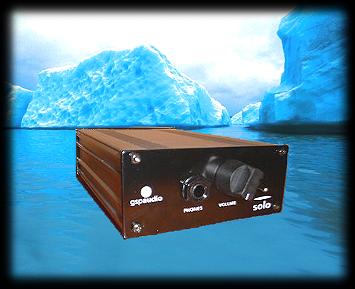
Now to the most important part of the review...... what does the amp sound like and is it worth shelling out £399 of your hard earned?
Graham indicated that he wanted me to be brutally honest and brutally honest I shall be. At one stage I e-mailed Graham advising him that I'd rather not review the amp as I honestly couldn't hear anything special and that I would be sending the amp back to him the following day. The bass was light, the soundstage flat as a pancake and the high frequencies rasped like a farting bee. I thought "£399 for this? you gotta be having a laugh" I likened it to a fully burnt in Musical Fidelity X-Can costing a mere £150........ as kind as Graham was supplying the amp for review I honestly couldn't justify the time reviewing this...... OR SO I THOUGHT!
The following day, armed with parcel tape and the box it arrived in, I went to disconnect the amp ready for its return journey to Yorkshire. I put my headphones on to ensure it was still working before I sent it back (as you do) and Yello "Pocket Universe" was still playing away on repeat from the previous day.
Hold on Harry! Had I been suffering from deafness the day before?, had Martians invaded overnight and sprinkled some magic dust over the amp?, Had Graham Slee broken into my house during the night and modified the amp? Had my Doctor decided to dress up as Santa Klaus, enter my house via the chimney and give my ears a syringe as a "thankyou" for being such a good patient?????
The difference was, quite literally, night and day. I, in my infinite wisdom, decided to reduce Graham's recommended 3 week burn in to 1 week thinking I would get an idea of the amp but that proved "not" to be a good move as this amp clearly requires a longish burn in period before it kicks into gear. When the amp does eventually kick in........... it kicks in BIG time!
I Decided to leave it connected for another 200 hours fed a diet of 24/7 "Radio 2" before listening to it again so I'll now review the sound quality "after" the burn in phase:
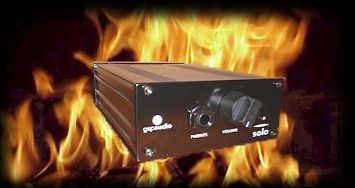

First up for a spin in the CD Player was an old favourite of mine Mike Oldfield's The Songs of Distant Earth. The track 'Oceania' was engagingly presented with good dynamic range and excellent tonal colour. The crashing of the waves on the shore came across as splashy and very realistic. Often lesser amplifiers struggle to reproduce the waves realistically sounding more like someone pouring a bucket of water over the pavement but the Solo gives you the impression you are actually on a beach, very impressive. The bass was slightly less impressive sounding a tad seperated from the rest of the range and didn't show the kind of integrated kick and "slam" I'm used to hearing on this track but the superb upper mid / treble really shone making the track very enjoyable on the whole.
To get an even better idea of the bass I listened to Wynton Marsalis Joe Cool's Blues The track 'Oh, Good Grief!' providing a nice mixture of piano, double bass and drums. This simple Jazz track was delivered impecably through the Solo, Herlin Riley's drums and cymbals showed great clarity and total absence from splashiness and the expressiveness of Benjamin Wolfe's stand up bass playing was clearly conveyed remaining tuneful and in total control with great extension. Everything was where it was supposed to be with each performer having a stable palpable image.
I tried a few other recordings to try to get to the bottom of the Bass discrepancy I heard on the Mike Oldfield track and couldn't replicate it with any of the other recordings I tried, this was extremely odd! Bass had both weight and definition with individual notes being laid bare and easy to follow, acoustic and electric bass instruments spelt out clearly the dynamics of the vibrating strings. It doesn't provide gut churning, toe curling, ear pounding bass (thankfully!) it integrates with the rest of the range making for a natural well balanced insight into a recording.
I wont list "every" single CD I listened to as I'd be here forever, instead I'll attempt to put into words what this amp did for "my" ears and trust it will be of help for anyone who is contemplating buying a headphone amplifier:
The first aspect of the Solo to impress was its midrange presentation. Wind instruments come across with a penetrating intensity with brass, in particular, sounding realistically "rasping" Piano notes have a truly percussive leading edge and electric guitar sounding three dimensional and totally "electric" (couldn't think of any other word to describe an electric guitar!!)
Drums are clearly portrayed, even the heights of snares, kick drum and high hat can be visualised and the start stops have no overhang. I'm not really a great lover of "vocals" in music preferring instruments over voices but Roger waters sounded pretty damned real to me through the Solo!..... I can't comment on female vocals as I don't have any albums featuring female singers (bad enough listening to them nagging let alone having to endure them singing too!!)
Let's get to the bottom line / cut to the chase! Is it a good amp, is it worth £399 and how does it compare to other amps I've heard?
Without a shadow of a doubt, the Solo is a very accomplished little amplifier. For your money you are buying a hand made amp which has been designed to last for many years. The Solo, obviously cannot compete with the mass produced amps pricewise due to the manufacturers massive buying power and contracted out labour resources (cheap labour) but it makes up for that with its charm and the feeling that you've bought something that's unique and far from run of the mill. Quality of build and longevity are things I value in a product and the Solo delivers.
The Solo sits at a very awkward price bracket (£399), the majority of the UK competition resides at the £129 - £250 end of the scale, with the Sugden headmaster at £600 being the exception. I can really only compare the Solo to The Musical Fidelity X-Can V2 as it is the only commercial offering I have extensive knowledge of (having owned one and modified many)
The X-Can V2 may, at first, seem a bargain at £150 but once you factor in an X-PSU (£200) and it's habit of going through exotic valves at a rate of knots...... that "bargain" soon turns into a VERY expensive, ongoing expenditure. The Solo is supplied with the PSU1 (the equivalent of the MF X-PSU upgrade) so the Solo requires no more upgrading..... you've got the "maxed out" amp from day one with the Solo. (unless you choose to buy the Solo intro for £299)
The X-Can V2, however, needs an X-PSU (or clone) to bring the best out of it.... we are now talking £350...... oh, and then the JAN 6922's have to be replaced with valves (tubes) that sound decent... we are now up to £400 - £500 dependant on the valves fitted..... then, for the ultimate in X-can V2 performance it's necessary to replace the capacitors with ones that don't bulge due to the excessive heat build up inside the V2....... ELNA cerafines etc., we are now up to £580. Happy with this, a "whooshing" sound appears in the right channel....... time for more valves methinks..... this is a never ending story and your initial £150 bargain can soon turn into a megabuck liability.
Sorry to dwell on the X-Can V2 but I'm just trying to show that the gspaudio Solo is a "what you see is what you get" amp with no need to "upgrade" The X-Can V2 is very like a Playstation, sold cheaply but you end up spending ££££££'s on games.
I seem to have gone off on a tangent there, what was the question again??? Oh yeh:
Q: "How does the gspaudio Solo compare to a stock X-Can V2?"
A: The Solo is a much more accomplished amplifier in every respect
Q: "How does the gspaudio Solo compare to an X-Can V2 with X-PSU, Mullard valve and Cerafine capacitor modded amp? (£500)
A: They both present music in a totally different way, the modded V2 sounding warm and ethereal with the Solo sounding slightly more integrated and open. I honestly can't say one is "better" than the other but I can say the Solo is probably better value for money in the long run in my opinion.
A mention on drive..... the Solo had no issues driving the HD600's, AKG K340's or the Grado's and had more than enough juice to do the job. I feel that Graham may want to lower the gain ever so slightly as the Solo goes "very" loud at the 9am position. It's not a Major issue but don't crank the volume up to 10am on your first listen............ it's Loud :-)
This review will be ongoing and "tweaked" to reflect any changes in the amps design. My thanks to Graham Slee of gspaudio for giving me the opportunity of listening to this amp.
Equipment used:
Source: Marantz CD17 KI signature
Headphones: Sennheiser HD 600 / AKG K340 / Grado SR225 (on loan, thanks
Stuart)
![]() Solo
2004 review here
Solo
2004 review here
Important Update!! SOLO Modifications:
Graham, not being entirely satisfied with certain aspects of the Solo that I (and others) brought to his attention, asked me if I would work with him (be a second pair of ears) to try and address these issues and get even better performance out of the amp. What an opportunity, I couldn't pass a chance like that up so agreed to take part in the Solo modifications, as I say, as a second pair of ears.
Two weeks of Graham burning the R&D candle at both ends later (progress report e-mails sent at 4am for example!!) he called me to say he'd cracked it and was sure it was an improvement over the original Solo "I'm chuffed it works!" as he modestly put it. He sent me a mod sheet up along with the components that were to be fitted in order that I could replicate his mods into the sample amp at my end.
I was very surprised when I opened the "mod bag" to find 12 components inside and even more surprised to find they would fit on the existing board without the need for an add on board!. A like for like component change (ie: a general purpose cap replaced with an exotic cap) would have been easy to understand but "every" single component change was completely different from the original component ie: a small value tantalum replaced with a whopping 1000uF electrolytic etc. Graham had obviously been doing some serious mathematical equations and this appears to be a total reworking of the original design.
He had been working on getting the the full potential out of the AD826, improving the bass, lowering the gain so the volume control wasn't so "immediate", improving the soundstage, improving the detail etc............. a very tall order indeed!
I spent an enjoyable few hours in the workshop performing the modification and it went painlessly with the amp measuring up to the specified 5V between pin 8 of op-amp and tab of voltage regulator (0V) when tested. Now for the moment of truth...... would all his hard work and efforts equate to better sound?
Well, I quite honestly couldn't believe my ears and certainly wasn't expecting "such" a pronounced improvement in sound quality over the original. This was a completely different amp I was listening to, no doubt about that, the slight veil I noticed when listening to the amp in its previous incarnation had been totally lifted bringing out bags of detail with a real sense of airyness and space around the musicians you could almost reach out and touch the musicians, the sense of placement was palpable.
The sheer energy and excitement that has been injected into this amp guarantees you'll pull out all your old recordings and will be under the cans for quite some time! I found myself listening to recordings that I haven't played for years..... I don't know what Graham has sprinkled over this amp but I can only call it "magic dust" That slightly detached bassline I'd noticed when listening to Mike Oldfield's "Oceania" has been replaced with a fast, integrated, toe curling deep bass that underpins the proceedings with authority and conviction yet blends in beautifully with the rest of the frequencies without being overpowering.
From Classical music to jazz to rock... this amp presents the music impeccably. If slam is called for it will slam hard, a Cello will sound mellifluous, a muted trumpet will rasp..... it does everything it should be doing and it does it with effortless ease. I keep using the word "energy" and that's how I would describe the overall presentation, there is so much going on with bucket loads of detail being ladled into your ears from all directions. I haven't heard such an exciting amp for quite some time and Graham has injected a Ferrari F-50 engine under the Solo bonnet.
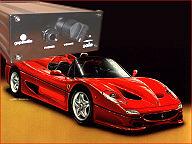
The "Energy" the "speed" the "attack" and the sheer "musicality" brings the goose pimples up on the back of my neck on certain tracks and that's quite an achievement. Graham took constructive criticism on board and has addressed not only the issues regarding bass, he's totally transformed this amp into a truly musical wonder. This amp Rocks.
The Solo will not be renamed MK4 as Graham says "All the Solo's are going to have the mod you and I tried from now on. All 2004 models will be modded. I'm not going to call it the Mk4, I'm just going to call it the Solo . This is as far as this particular product can go".
I believe Graham will be offering an upgrade service to any existing MK111 owners who would like to benefit from the mods.
A twist to the tweak tale:
Further to Graham's mods I decided to try out an AD823 Op amp in place of the AD826 op amp as I had good experience of the AD823 in other amps. It was clear, from the moment I switched the amp on, that the AD823 sounded even better than the AD826 (and then some!) I called Graham and asked him to try an AD823 at gsp headquarters and see what he made of it.
A few days later I got a call from a very enthusiastic Graham who was absolutely bowled over by the AD823. He had optimised the Solo circuit to get the best out of the AD823 and he told me what additional components I should change in order to get the absolute maximum performance out of the AD823.
It was out with the soldering iron again and under the bonnet to solder in the additional components. Oh My God! no wonder Graham was so enthusiastic! The difference between the optimised AD823 and the AD826 was truly night and day... Just when I thought it couldn't get much better.... it did! Graham explained that the "AD826 had the equivalent of a Mars bar when it was looking for current whereas the AD823 was swimming in a sea of chocolate" Everything was so much clearer, so much more attacking and so much BETTER in all departments.
The Solo has now come of age and Graham was so happy with the sound he decided to rework the enclosure so it looks as good as it sounds. This was a great exercise and it was a pleasure to be involved in the transformation of the Solo into this box of sonic magic:
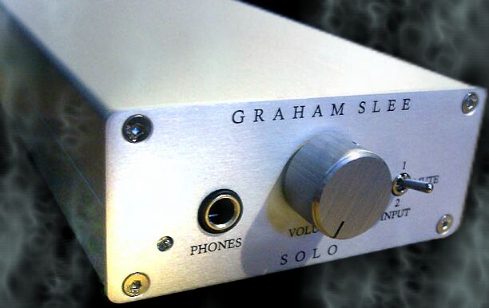
The all new SOLO

![]() Solo
2004 review here
Solo
2004 review here
Manufacturers Comments:
People are flocking in ever increasing
numbers to the Internet for assistance in making The Informed Choice.
Internet forums exist to discuss the merits and use of products in numerous
fields of interest.
Very often they are the only source of unbiased opinion. They allow freedom
of speech, which may be good or downright awful for the seller, but nonetheless
provide vital opinions for the buyer to consider.
Rock-Grotto is a website run by one of the most trusted and prolific contributors
to the Head-Fi.org forum. It is a resource which visitors to the forum,
as well as members of the forum, can turn to for opinion. Opinion founded
on a pure enthusiasm for the hobby of headphone listening.
Manufacturers who avoid a resource such as this, do so at their peril.
Perhaps it is not practical to submit product to every website of this
nature, and I for one could not submit to all, but I have found the experience
in submitting my Solo headphone amplifier to Rock-Grotto very worthwhile.
It has confirmed to me that the MkIII Solo is a musical and value-for-money
headphone amplifier. But more than this, it has helped me hone the product
into something better still, with the kind assistance of this sites webmaster,
and its Head-Fi forum supporters.
I would like to thank Rock-Grotto for extending its review facilities
and professional writing style to the Solo and for the additional exposure
it will undoubtedly extend to my products.
Thank you.
Graham Slee
gspaudio
![]() Solo
2004 review here
Solo
2004 review here

